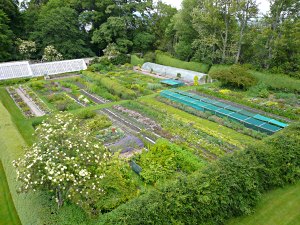 |
| Poyntzfield Herb Nursery |
Our day started with ginger root tea: grated, steeped and infused with honey a revitalizing and warming tonic to counter the crystalline skies outside. Duncan Ross had joined us, far from his herbal estates on the eastern reaches of the Black Isle to teach us rootimentary (couldn’t resist…) truths about composting and efficient herb growing.
First we enjoyed a virtual trip to his Victorian walled gardens, fortified against the glowering Highland fringe by 12 foot walls, sturdy hedging, poly-tunnels and deep trenches of compost and seaweed. A beautiful mosaic of green, grey beds, Poyntzfield Gardens grows over 450 types of herbs that’s up from the original 70 they started with in the 1970’s and sells throughout the world. Secret to their success is a triple row of compost bins slowing digesting and decomposing the efforts of last year’s harvest. Wild weeds (herbs?) grip and root to the upper layers exposing an archaeological striation of the midden below.
But the day was too nice to miss so we abandoned our pens and tea and took off to the practical beds of the RBGE’s nursery gardens - there to establish with secateurs, pitchforks and spades our very own patches and prepare the ground for next year’s abundance. We carefully plucked the seed heads of dried yarrow, fennel and borage, snapped off the gritty broad bean pods, pulled comfrey and horseradish roots and catapulted heaps of expired herbaceous material onto the Herbology compost heaps.
Gently turning the soft earth with fingers and forks, we cajoled the last weeds and stones from the summer field left the beds to sleep under a snug blanket of black plastic
No comments:
Post a Comment